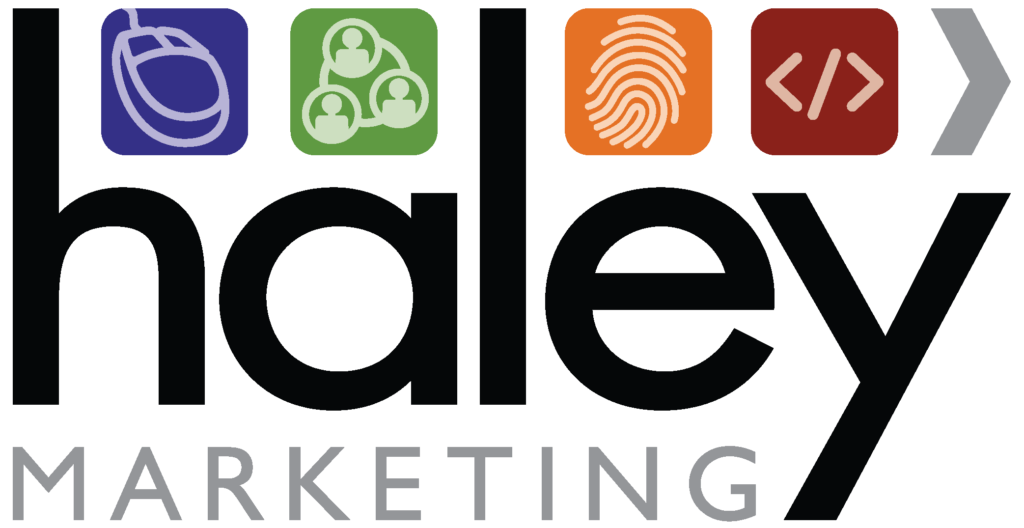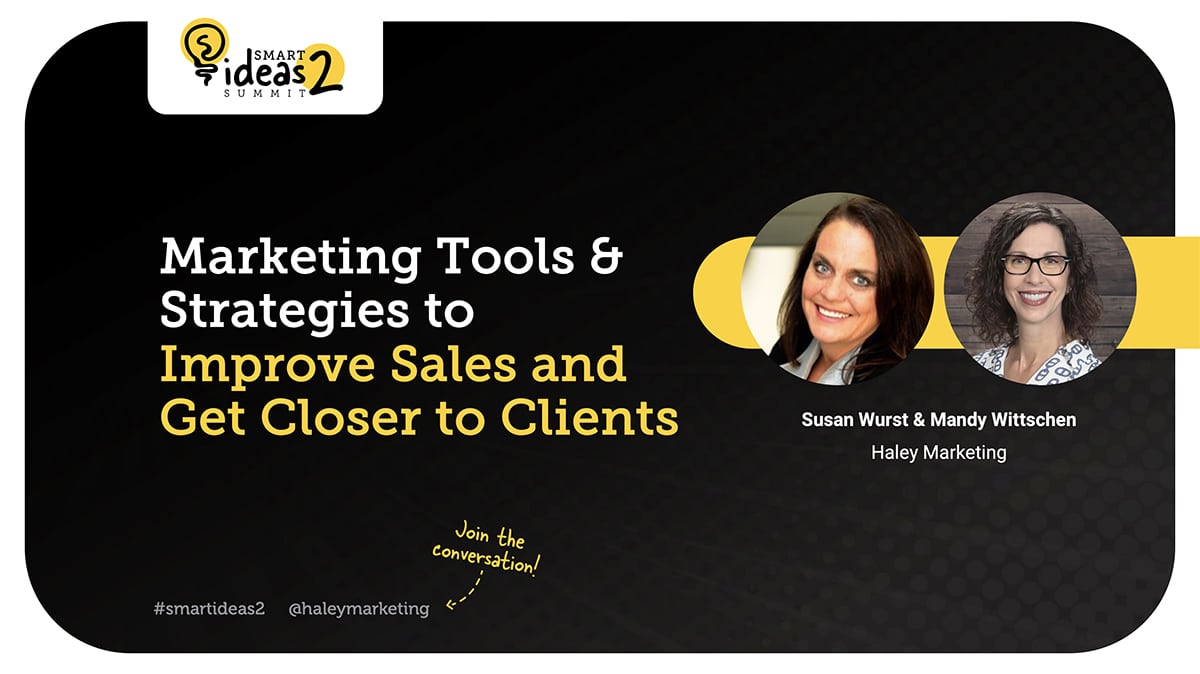The SMART IDEAS Summit 2 was a huge success – thank you to everyone who attended!
If you missed a session or want to rewatch or share any of the presentations, we have great news:
The SMART IDEAS Summit 2 Content Is Available on Demand!
Access the free recordings and slides for 14 educational presentations from some of the smartest minds in staffing here. Simply enter your contact information to access the recordings, and then click on any session to start viewing!
Session Recap: Marketing Tools & Strategies to Improve Sales and Get Closer to Clients
In this presentation, Susan Wurst (Director of Account Management) and Mandy Wittschen (Director of Talent & Training) share a simple, proven model to capture staffing decision-makers’ attention. Generate more inquiries. And drive more sales in our uncertain economy:
Video Transcript
Mandy Wittschen:
Susan and I are here to talk to you about marketing tools and strategies to improve sales and get closer to your clients.
For more than a year now, the staffing industry has been focused very heavily on recruiting, and with good reason.
Why is now the time to get closer to your clients and other employers?
Many of today’s presenters have already touched on these reasons, such as economic volatility and talks of recession. If you’ve been in the industry for any length of time, you’re likely familiar with the cyclical nature of staffing. But like Barry Asin said earlier, things are just weird right now. This uncertainty calls for more flexible and temporary solutions, and this means that employers need your help now more than ever.
You could unexpectedly lose key clients during a period of uncertainty like this, but if you’re continually prospecting and driving business with smart marketing, those client losses won’t hurt your bottom line as much. And the early bird gets the worm: those firms who do the work to get closer to clients now will be ready for anything.
Keep in mind that it takes a while for marketing efforts to take hold. You have to create the right strategy. You have to concept your campaigns. You have to build your list. You also have to build out the individual campaign elements and then execute everything. So, kick-starting your client marketing now will put you ahead of your competitors and right in front of employers when they need you most.
If you want to thrive in this economy, stay visible, be proactive, strategic and smart about your marketing, and get closer to your clients by improving your account management function. Now let’s talk a little bit about how to do these things.
What are some of the best ways to strengthen staffing business relationships and grow new ones in today’s environment?
We’re going to share two main vehicles today: integrated direct marketing, which we call IDM, another marketing acronym for you, and account management.
Before we dive into IDM though, I want to take a step back and talk about the buying process itself.
What is AIDA?
Well, it’s a woman’s name, but it’s also a marketing acronym used to identify the stages a prospect goes through during the buying process, or the purchasing funnel, for a product or service.
So, if you just use your imagination for a little bit, you have a prospect who doesn’t know anything about your company up the top of the funnel, and then you have a customer down at the bottom of the funnel. Let’s walk through this model.
- Attention. At the top you have the attention phase, and this is about increasing visibility. It’s about getting found. It’s about cutting through the clutter.
- Interest. Then a prospect will move into the interest phase. This is where you need to give them some sort of a reason to meet with one of your sales reps, either by sharing great content or sharing great ideas, or proposing great solutions.
- Desire. From there, the prospect will start to build a desire to work with you, and you can achieve this by providing them with a reason or motivation to buy that’s compelling. This is typically done by demonstrating a combination of warmth and competence to build that trust, along with proposing unique solutions that are right for their business problem.
- Action. Then finally you want them to take action, and this is where it’s really important to make it easy for a prospect to buy from you. You want to reduce as much friction in the process as possible and make it easy for them to take action.
If you’re in staffing, you want to apply this AIDA model to drive prospects through your sales funnel and ultimately get them to buy from you.
Now you’re familiar with the AIDA model, we’re going to review how to use it in your client marketing to capture decision-makers’ attention. You can use it to generate more inquiries about your firm and your solutions, and ultimately you can drive more sales from your top prospects and your existing clients. Best of all, it works. It generates between two and 10 times the responses compared to cold calling.
Why does integrated direct marketing work so well? What makes it so powerful and so effective?
There are several reasons, and I’ll talk a little bit about each of them.
First of all, it uses multiple communication channels and it connects with people in the ways that they want to be reached. Tom just showed a really cool diagram that I liked that was a good complement to what I’m explaining here. You can connect with people via direct mail. You can use email. As Tom mentioned, you can even embed video into that email. You can create bespoke videos that actually speak directly to your prospects if you want to, or make more general ones that you could do a one-to-many approach.
You can use social media, such as LinkedIn Mail or Facebook Messenger. You can use text or SMS. You can use phone calls with sales scripts, and you can even include PPC elements for lead generation or remarketing.
The second reason IDM is so effective is that it leverages that AIDA model that I just described, and it drives prospects through your sales funnel. IDM uses marketing to create awareness, to position your business, to build desire for your services, and then it makes it really easy for that employer to take action in whichever way they prefer.
Next, it’s strategic. Integrated direct marketing follows a structured process that systematically goes after every prospect with a consistent sequence of activities and reaches people the way they want to be reached.
Finally, it’s efficient. As you know, staffing is rarely a one-call close, and cold calling burns salespeople out. They can only contact so many people in a day. Integrated direct marketing uses marketing to do the heavy lifting for your salespeople. It helps warm prospects up and increases those call-to-appointment ratios.
So, when a salesperson does pick up the phone to reach out to a prospect, they’re calling someone who’s not only heard of your company, they know what you do and how you do it differently, and they’re also more positively predisposed to talking to your sales rep, which will also make them more efficient.
How can you use integrated direct marketing to drive staffing sales?
A well-designed and executed campaign is going to use multiple marketing channels to systematically advance individuals through your sales funnel by increasing visibility, like we talked about at the top of the AIDA funnel there. By staying in front of customers when account managers aren’t there in person, they can’t always be on site. By strengthening your positioning so that clients and prospects understand the unique value that you deliver, what you do, and then how you do it differently and better than your competition.
It’s great because it keeps your firm top of mind so that when an employer does have a staffing need, they think of your firm first. Then it also helps you educate clients and prospects on the strategic value of staffing in today’s market conditions.
It also helps you build relationships by sharing high-value content that addresses employers’ challenges and pain points. IDM allows you to demonstrate the ROI of your services in our current economy and job market. Case studies and testimonials are perfect for this.
Integrated direct marketing also warms prospects and lowers sales resistance, and ultimately it improves the efficiency and success of your sales team.
How is an integrated direct marketing campaign structured?
To wrap things up here, I wanted to show you an example of how an integrated direct marketing campaign could be structured.
Now, bear in mind that each campaign is going to be unique. It’s going to depend upon your business and what you’re trying to achieve, what your goals are, what your budget is, who your audience is, how large that audience is, and also your current sales activities.
I think Tom mentioned this as well too. Marketing and sales, they cannot operate successfully in silos, and integrated direct marketing is a great way to merge those two functions to achieve more.
Okay. So, taking a look at this diagram, you’ll see that prospects and clients are treated differently. Obviously, prospects are going to need initial steps. They may not even know about your staffing firm. You do need to invest in ways to capture attention, to create awareness, to educate them, and to properly position your firm.
You could start a campaign with some sort of an oversized mailer that’s attention-grabbing and keys into the prospect’s pain points or their business challenges, and then introduces your staffing firm. For me, this is where creativity is key, and it really pays to invest some time in the creative theme and the concept behind your campaign. You need to find a way to cut through the clutter and capture that decision-maker’s attention.
And then subsequent pieces could be a digital or printed ebook. It could be an article, it could be blog posts, it could be sell sheets, whatever you think would be appropriate, but the goal is to educate prospects about the realities of today’s market and explain to them how smarter staffing and recruiting can help them achieve their goals.
Ultimately, you want to position your firm as the ideal partner for their business and back up those claims with testimonials and case studies. I think Vicki mentioned it earlier. It’s not so much about what you say; you need to provide that proof through the results you deliver and through what your customers say about doing business with you and the results that you deliver for them.
Then after that fast-track, a sales rep would place a call and try to get an appointment. I even recommend creating either a suggested sales script or at least talking points to help guide the conversation. If that call doesn’t lead to an appointment, the prospect would then move into the nurturing phase of the campaign, along with clients in warm leads, so that the sales rep continually has new reasons to make follow-up calls and they’re not just interrupting their day and just stopping by to drop off of a box of donuts. Although donuts are great, aren’t they?
So, clients and warm leads are already aware of your firm and they understand what you do. So they would enter the campaign a little bit differently. You could start with a simple introduction letter, for example, and then follow up with the same multi-step, multi-channel nurturing campaign as prospects.
You can see in this diagram that you can and should use multiple methods of communication: calls, emails, direct mail pieces, video, connecting and reaching out on social media to generate the best results. Choose the right mix based on how your audience prefers to communicate.
As you can see, the ultimate goal of this campaign is to get appointments that lead to sales. Now that you know how integrated direct marketing can help you open doors with prospects and drive sales, Susan’s going to tell you about a second strategy for improving sales and getting closer to clients, which is account management.
So, take it away, Susan.
Susan Wurst:
Thanks, Mandy. Mandy, you did a great job outlining how following the AIDA model is going to improve sales. Applying a consistent strategic and efficient methodology to your sales process is important and proven to be effective in turning prospects into clients.
But what happens after they become a client? The goal is obviously to keep them. Staffing is a people-first industry. We all know that. If you remember that and focus on that, and strengthen those relationships, the results will be a loyal client base.
The theme of this summit is preparing for anything. Staffing companies who get closer to their clients now will be ready for anything. Over the next few minutes, I’m going to talk about what you can do from an account management perspective to position yourself as a trusted partner to your clients and give you some ideas on how to get in front of those clients to bring that relationship to the next level.
Position yourself as a trusted partner.
One way to strengthen your relationship is to position yourself as a trusted partner. Make yourself invaluable. Educate your clients on all the services you offer; don’t just assume that they know. The more services you provide to them, the more valuable you are as a partner and the harder it is for them to leave you.
Humanize the relationship.
Your clients are your clients, and while your relationship is of course of a professional nature, getting to know them as a human and acknowledging that you see them as a person can go a long way. So, find out a little bit about their personal life and make reference to those details and conversations. Ask about the picture of their kids or grandkids on their desk. Real-life lesson: Don’t assume those little darlings in the picture frame are grandkids.
Remember their dog’s name. Ask about their vacation. Call them on their birthdays or when their favorite sports team had a great win or loss. That’s sometimes even more fun. Send a handwritten card if they’ve had a death in the family.
Get feedback and act.
One of the downsides of having a close relationship with a client is they may be hesitant to give you honest feedback for fear of damaging that relationship. When doing a quarterly business review or a project recap, ask the direct question: “How do you think we are doing for you?” Then stop talking and listen.
If their feedback is generic, you may need to change your approach and asks questions like, “What would you like to see us do differently next time?” Then not only make changes, but follow up with them to let them know what those changes are. The worst thing you can do is ask what you can do differently to improve their experience and then do absolutely nothing.
Be transparent.
From the top down, make it okay for your team to be transparent when things don’t go well and own up to your mistakes. We’re really big on this at Haley Marketing. Make it okay for your staff to say, “I screwed up.” When you think about the poor service events you’ve personally had, where you’ve experienced true transparency, you realize how rare transparency actually is, and it’s that rarity that will make your company stand out. Make sure you train your team in the difference between being transparent and making excuses, because there is a fine line.
Tell your clients what they don’t want to hear. This sounds crazy, but give your honest opinion. As an account manager, you naturally want to be agreeable and avoid awkward, uncomfortable conversations. I mean, let’s face it, you have enough of those conversations without instigating them yourself. Telling your client what you think they want to hear in the long run is going to damage not strengthen your relationship.
Is the high turnover of the temps because their supervisors are treating the employees poorly? Are you having a problem making placements with them because the pay rate or salary is crazy low? These are hard conversations to have but, in the end, giving your honest opinion will earn their respect and demonstrate that you have genuine concern for their success.
Now for some ideas on getting in front of your clients. We all know that getting in front of your clients accelerates achieving that deeper relationship. I’m not giving you a huge revelation here. I’m hearing from clients that one good thing to come out of COVID is where previously their clients would just say, “Send me an email,” they’re now more open and willing to have in-person visits or, at the very least, hop on a video call.
The more you’re in front of your clients, either in-person or via video, the easier it is to build that trusted relationship, but just popping into their office unannounced without a reason is generally not very well received. You need to have a purpose.
Some ideas. Set up a meeting with the hiring manager to meet the frontline supervisors, or better yet, ask to conduct a focus group with those people on what you can do to improve their experience. This is also a great way to build your bench of decision influencers.
Get involved in your local chamber or other business organizations. This is generally viewed as a networking platform to get new business, but chances are some of your clients are at these meetings and events as well.
For accounts where you have a large number of temps, have an employee of the month award and present it along with a gift. This is also a great way to passively recruit your competitors’ employees when they see how valued your employees are to your company.
Do introductions of other team members to your client. Having the salesperson do an in-person introduction to the people they’ll be working with on a daily basis is a great way to speed up the building of that relationship.
Add value.
Offer to hold a training for their hiring managers on how to conduct effective interviews. Remember, you’re the experts on this. If there are a large number of new assignment starts, offer to send someone on-site to assist with check-ins of not only your employees but other services’ employees.
Demonstrate the technology you use and how it allows you to provide a better service experience to them.
Finally, get creative.
This is one of my favorite quotes ever, and I have to give credit for this and the next two ideas where it’s due. This old gem is from Jamie Higdon, from TempStaff. TempStaff does an amazing job getting creative with finding reasons to get in front of their clients. “Almost anyone will see you if you show up with food.” So, use silly holidays as an excuse to drop off food, like National Milk Day or National Junk Food Day.
This idea I absolutely love. During Girl Scout cookie season, buy mass quantities of cookies and drop off a box at a client site months after cookie season has ended. One year I found a box of girl scout cookies in December in the bottom of my freezer and it was like the best day ever. So I would imagine this going over really well. I mean, who doesn’t love a thin mint? And then the added benefit is you make some little girl scout really happy!
One final thought.
Always set the next in-person meeting before you leave to ensure the clients don’t fall through the cracks.
While a lot of these ideas are event-driven, provide your team with a general roadmap so they aren’t just throwing darts at a dartboard. For example, for new clients, first do a team member intro meeting, then a meeting to get feedback, then a supervisor focus group, and so on.
So, in closing, now is the time to prepare for anything. If you have a plan for attracting new clients and how to nurture new and existing relationships, you’ll be prepared for whatever’s coming. All right.
David Searns:
All right. Well, thank you both. Good stuff. So, Mandy, we’ve done a lot of integrated direct marketing campaigns over the years and in the last presentation with Tom people were concerned about getting the mail through. Just in your opinion, when you have a direct marketing campaign, what gets someone interested in opening whatever they’ve received?
Mandy Wittschen:
I think it’s a combination of timing, creativity, and then having the right message. I know with Haley Marketing we’ve experimented with different size and shaped packaging, different colors, and different labels applied to the outside. You have to make whatever’s coming across that person’s desk visually interesting to try and stand out from the other bills and things that they’re probably receiving.
But once they open that box, there has to be something substantive there that’s going to make them stop and say, “You know what? This relates to me. This is talking to me.” That’s all about getting inside your prospect’s head and trying to think through what types of decisions are they making, what keeps them up at night, and then being able to key into that. That’s where, I think, the creative concept behind it too, behind the campaign, is really important too.
David Searns:
Yeah. I think you’re nailing that AIDA model because it’s one thing to get their attention because a package showed up on a desk, and I think Brad suggested in the chat he’ll recommend a FedEx because no matter where somebody is, there’s no way a FedEx is going in the garbage unopened. So that’s going to have a 100% open rate. But then once they get inside the package, you’re exactly right. You have to already kind of be in their head and think about, “What’s going to resonate with this type of decision-maker that I’ve set out to reach?”
One of the places I’ll share from our own experience that I love integrated direct marketing is when you sell at conferences. So, if there are trade events, if you go to national conferences, if you’re in IT staffing or you’re in healthcare and you go to conferences in your field, if you’re a sponsor or you’re an exhibitor, or you do anything possible to get the list of people who are going to the event, then you take this integrated direct marketing to the event attendees to drive people to your booth.
We’ve seen massive changes in the number of people who come to visit a booth when that integrated direct marketing is used around an event. What we try to think about is, “How far in advance of the event can we get on somebody’s calendar?” Because when you show up at a trade show, it’s just bing, bing, bing, thing, thing, thing. You actually have to be on their agenda before they step into the car or jump on the plane to go to that event.
Now, Susan, I want to flip around to account management. I think one of the challenges with account management is how do you get their time. We see this sometimes with our clients. Clients are busy. How do you get them to give you the time to sit down to have these kinds of conversations?
Susan Wurst:
Excellent question, David. I’ve always maintained clients like to choose their amount of engagement, and lack of engagement isn’t necessarily a predictor of something wrong, but you do need to be a little bit sensitive to it.
So what I always recommend is if they don’t want to have time for you, keep it short. Send them a quick article that you think that they might find useful, or just a quick email saying, “Just checking in. How is everything?” Or just a quick voicemail: “Was thinking about you.” This is where those extra touches come in, the more personal touches come in.
As far as getting clients to sit down and have those conversations, again, if you can get it scheduled ahead of time. I know personally, it’s easier for me to commit to an hour-long meeting that’s two months out than it is for me to commit to something this week. If it’s on someone’s schedule, they’re going to make time for it and they’re more likely to agree to the meeting if it’s farther out in the future, which ties back to setting that next meeting while you’re at the current one.
David Searns:
Yeah, I was going to say that. That’s a really great point, because you might be able to in the beginning, when you’re first starting the service experience with a client, set the expectations: “Hey, we want to make sure that things are going really well. So let’s put these meetings on our calendar throughout the course of the year,” where you’re doing them at a higher level, like QBR that was mentioned this morning, you’re doing that quarterly business review.
Also, to an earlier question that was asked, like, what do you do if you have a rookie that has no credibility, well, you can’t send them in a QBR review and say, “Hey, go figure it out with the client.” Having it booked also allows you to get your senior people, sort of as Mike said, those three levels. I can now bring in people at other levels to make a really meaningful client interaction.
So you do all these touches. You get in front of people. Are there things you can do at the end of the client meetings, the client touches, that help improve retention, help improve the longevity of the client?
Susan Wurst:
At almost every call I have with a client I ask, “How are we doing for you? How do you feel it’s going?” Getting that extra piece of feedback really goes a long way because it does allow you to act upon it. I think that is really, really key.
Getting curious. We say this at Haley Marketing all the time: Be curious! Ask the same question three different ways, you’re going to get three different answers. Take the third one!
David Searns:
Yeah. Take the third one! Because if you ask it in different ways, you’ll finally get to the real answer.
Want more smart ideas from the smartest minds in staffing?
Access the free recordings and slides for 14 educational presentations from the SMART IDEAS Summit 2.













